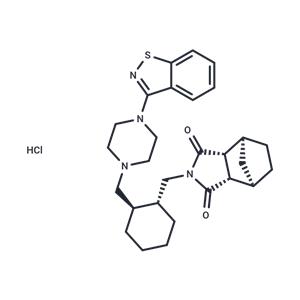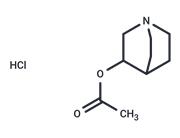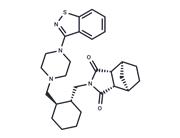| Name | Lurasidone hydrochloride |
| Description | Lurasidone hydrochloride (Lurasidone HCl) is a thiazole derivative and atypical antipsychotic agent that functions as a dopamine D2 receptor antagonist; serotonin 5-HT2 receptor antagonist, serotonin 5-HT7 receptor antagonist, an antagonist of the adrenergic α2A and α2C receptors, as well as a partial serotonin 5-HT1A receptor agonist. It is used in the treatment of schizophrenia and bipolar disorder. |
| In vitro | Lurasidone antagonizes dopamine-stimulated [35S]GTPγS binding at human dopamine D2L receptor in a concentration-dependent manner with a KB value of 2.8 nM. Lurasidone antagonizes 5-HT-stimulated cAMP accumulation in the CHO/h5-HT7 cells with a KB value of 2.6 nM. Lurasidone partially stimulates [35S]GTPγS binding to the membrane preparation for human 5-HT1A receptors with a maximum effect of 33%. Lurasidone dose-dependently increases the ratio of DOPAC/dopamine in rat frontal cortex and striatum. [1] |
| In vivo | The inhibitory actions of Lurasidone on MAP-induced hyperactivity persists for more than 8 hours, and the ED50 values of the action at 1 hour, 2 hours, 4 hours, and 8 hours after the treatment are 2.3 mg/kg, 0.87 mg/kg, 1.6 mg/kg, and 5.0 mg/kg, respectively. Lurasidone (1 mg/kg–10 mg/kg) dose-dependently inhibits conditioned avoidance response in rats with ED50 of 6.3 mg/kg. Lurasidone dose-dependently inhibits TRY-induced forepaw clonic seizure and p-CAMP-induced hyperthermia in rats with ED50 of 5.6 mg/kg and 3.0 mg/kg, respectively. Lurasidone (0.3 mg/kg–30 mg/kg) dose-dependently and significantly increases the number of shocks received by rats in the Vogel's conflict test with MED of 10 mg/kg. Lurasidone (3 mg/kg, 2 weeks) significantly suppresses hyperactivity behavior in olfactory bulbectomy model rats. Lurasidone (700 mg/kg–1000 mg/kg) slightly prolongs the duration of loss of righting reflexes elicited by hexobarbital (anesthesia) in mice in a dose-dependent manner. [1] Lurasidone (30 mg/kg, p.o.) significantly and dose-dependently reverses the MK-801-induced impairment of the passive-avoidance response of rats. [2] Lurasidone (3 mg/kg p.o.) potently reverses MK-801-induced learning impairment in the Morris water maze test in rats. Lurasidone (3 mg/kg p.o.) potently reverses MK-801-induced reference memory impairment and moderately but not significantly attenuates MK-801-induced working memory impairment in the radial-arm maze test. [3] Lurasidone (10 mg/kg) treatment increases total BDNF mRNA levels in rat prefrontal cortex and, to less extent, in hippocampus. Lurasidone (10 mg/kg) significantly increases the levels of mature BDNF protein in rat prefrontal cortex, without affect the protein levels of the neurotrophin (both precursor and mature forms) in hippocampal extracts. [4] |
| Storage | Powder: -20°C for 3 years | In solvent: -80°C for 1 year | Shipping with blue ice/Shipping at ambient temperature. |
| Solubility Information | DMSO : 5.3 mg/mL (10.02 mM), Sonication is recommended.
|
| Keywords | SM-13496 (Hydrochloride) | SM13496 | SM 13496 | Norepinephrine α2C | Lurasidone | DopamineReceptor | Dopamine Receptor | Dopamine | D2 | 5HTReceptor | 5-HT7 | 5-HT2A | 5-HT1A | 5-HT Receptor | 5HT Receptor |
| Inhibitors Related | Trifluoperazine dihydrochloride | Alverine citrate | Dapoxetine hydrochloride | Cefaclor monohydrate | Clozapine N-Oxide | Octopamine hydrochloride | 1,8-Cineole | L-DOPA | Creatine | Oxolinic acid | Trazodone hydrochloride | Mianserin hydrochloride |
| Related Compound Libraries | Pain-Related Compound Library | Anti-Neurodegenerative Disease Compound Library | Bioactive Compound Library | Membrane Protein-targeted Compound Library | EMA Approved Drug Library | Drug Repurposing Compound Library | Inhibitor Library | Anti-Cancer Approved Drug Library | FDA-Approved Drug Library | Bioactive Compounds Library Max | GPCR Compound Library | Anti-Cancer Drug Library |

 United States
United States






